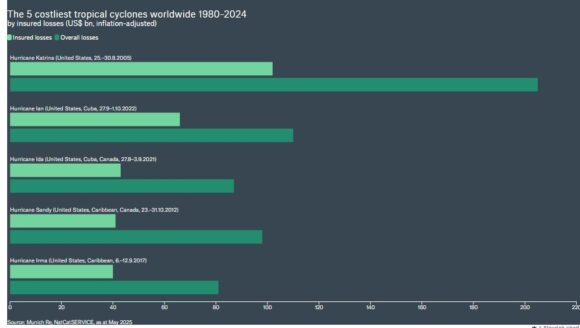Current climatic conditions suggest that there will be a slightly above-average number of storms in the North Atlantic during the 2025 hurricane season, according to Munich Re in its Hurricane Outlook 2025.
However, Munich Re warned that this year’s outlook is subject to more uncertainty than last year’s, as key climatological framework conditions remain unclear.
Leading research institutes predict 14-19 named storms in the tropical North Atlantic this year, said the reinsurer, quoting leading research institutes, Colorado State University, Tropical Storm Risk, University of Arizona, and NOAA.
“Seven to nine of these could develop into hurricanes, of which three or four might become major hurricanes with wind speeds of over 110 mph (177 km/h),” Munich Re said.
The official hurricane season begins on June 1 and ends on November 30.

The reinsurer said these numbers are slightly above the long-term average for 1950-2024, with 12.5 named storms, 6.5 hurricanes and 2.6 severe hurricanes. However, they are in line with expectations for the cyclical warm phase in the North Atlantic since the mid-1990s, with 15.8 tropical storms, 7.8 hurricanes and 3.5 major hurricanes.
However, Munich Re cautioned that the differences between predictions among researchers for 2025 are greater than usual – mainly because of the uncertainties brought by water temperatures and the current status of the natural climate pattern known as ENSO (El Niño/Southern Oscillation) in the equatorial Pacific.
“It’s harder to make predictions for the hurricane season this year compared to last year, as the ENSO phases and development of water temperatures are still very unclear,” commented Anja Rädler, a meteorologist and climate expert at Munich Re, in a statement.
“In any case, diligence is called for, since the latest observations hardly indicate a quiet storm season,” she cautioned. “According to a study conducted at Colorado State University, under similar conditions the U.S. was hit by three devastating hurricanes in 2017 – Harvey, Irma and Maria. It was the second-costliest hurricane season in history. Yet in 2006, a year that began with similar conditions, there were far fewer storms, and losses were under the US$1 billion mark.”
Diving into the details of temperatures and the ENSO climate pattern, Munich Re said sea surface temperatures in the tropical Atlantic are currently slightly above average but lower than last year’s record-breaking temperatures. “[P]redictions vary when it comes to how warm the Atlantic will be during the main phase of the hurricane season, from August to October,” the report said.
As for the ENSO climate pattern in the equatorial Pacific, Munich Re explained it is currently in a neutral phase – in other words, it is neither an El Niño nor a La Niña event. “ENSO fluctuations have pronounced effects on cyclone activity: El Niño phases tend to limit hurricane activity in the North Atlantic, whereas both neutral and La Niña conditions are conducive to cyclone development,” the report said.
Munich Re noted that neutral or even La Niña conditions are currently the most likely scenario for the main phase of the hurricane season (August to October), which creates favorable conditions for tropical cyclone development.
“Accordingly, the current view is that this combination – above-average water temperatures and cyclone favorable ENSO conditions – makes a level of storm activity slightly above the long-term average probable,” the report added.
Typhoons in the Northwest Pacific
In the western part of the North Pacific, ENSO conditions also affect the region’s typhoon season, “but with roughly the opposite effect to that on cyclones in the North Atlantic.”
La Niña conditions generally favor typhoon activity that is below the long-term average, the report said, citing a Tropical Storm Risk study, which currently predicts a level of activity in 2025 that roughly matches the 30-year average (1991–2020) of 25 named cyclones, 16 typhoons and nine severe typhoons in the highest 3–5 category.
Tropical Cyclones in 2024
In 2024, 18 tropical cyclones were recorded in the North Atlantic, including 11 hurricanes, five of which developed into major hurricanes (Categories 3-5 on the Saffir-Simpson Wind Intensity Scale). Losses in Florida from Hurricanes Milton and Helene made 2024 the year with the second-highest overall global losses from tropical cyclones in the last 10 years, Munich Re said.
Topics Windstorm
Was this article valuable?
Here are more articles you may enjoy.



 Illinois Attorney General Announces $120M Settlement With Monsanto
Illinois Attorney General Announces $120M Settlement With Monsanto  Litigation Finance Hits a Wall After Bets on Huge Gains Falter
Litigation Finance Hits a Wall After Bets on Huge Gains Falter  Surveys Show Concerns About Florida Market, But Consumers Are Warming Up
Surveys Show Concerns About Florida Market, But Consumers Are Warming Up  US E&S Outlook No Longer Positive: AM Best
US E&S Outlook No Longer Positive: AM Best 

